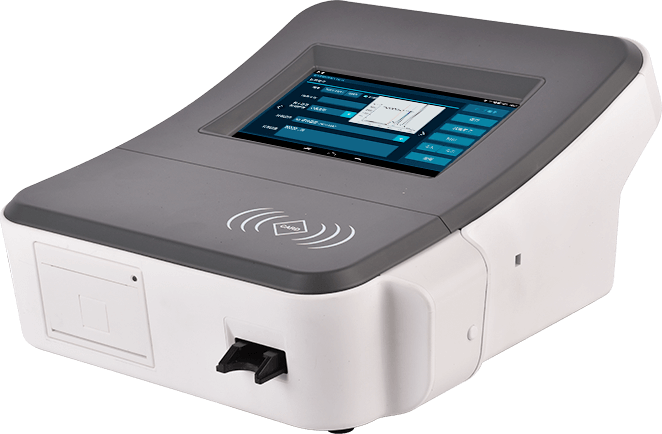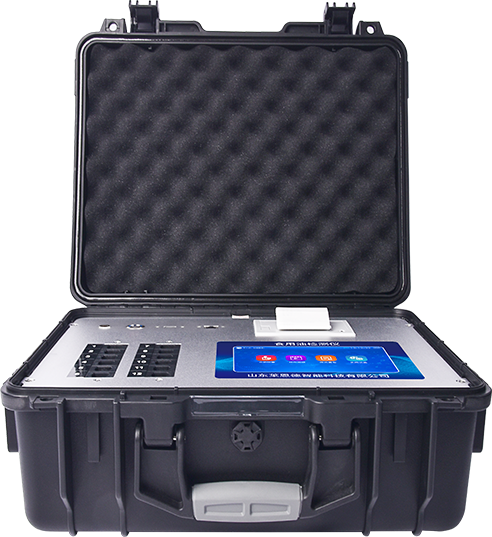
Feed Mycotoxin Analyzer
- Product Number:LD-L02
- Product Difference:Android operating system, paired with a thermostat, enables fast and accurate quantitative detection
Product Introduction
The feed mycotoxin detector employs a fluorescent quantitative rapid detection principle, primarily used to measure mycotoxin levels in grain, oil, and feed products, including aflatoxin B1, aflatoxin M1, zearalenone, vomitoxin, fumonisin, and others. The testing samples include grains and cereals (rice, corn, wheat, barley, sorghum, etc.) and their products, feed and its raw materials, edible oils, milk and its products, and more. Sample pretreatment is simple, and the entire detection process takes 12 minutes. The product is suitable for local grain warehouses, grain production enterprises, feed mills, various livestock and poultry farming enterprises, flour mills, food processing plants, third-party testing institutions, and regulatory authorities at all levels.
Product Features
High stability: Imported fluorescent microspheres are used, with uniform particle size, ensuring product stability from the source and good reproducibility within and between batches. The test strips can be stored at room temperature and do not require refrigeration. After testing, the test strips can be dried and stored for one year, ensuring traceability of results.
Built-in quantitative standard curve: The built-in standard curve eliminates the need for standard samples and standard curve creation during testing, saving costs and preventing operator exposure to vomitoxin, thereby ensuring operator safety.
Versatile use: Equipped with a temperature-controlled device, one strip per well, automatic timing, and unaffected by external temperature and humidity, it is suitable for a wider range of environments.
Low supporting requirements: Low requirements for supporting pretreatment instruments, equipment, and personnel; operators only need short-term training to become proficient.
Rapid and accurate quantification: Combines the advantages of colloidal gold rapid testing, enzyme-linked immunosorbent assay quantification, and chromatographic accurate detection to achieve rapid and accurate quantification testing.
On-demand testing: No restrictions on sample volume; can test individual or small batches of samples on-demand, or process large volumes simultaneously, and supports on-site testing.
High cost-effectiveness: Achieves chromatographic detection quality and results at one-third the cost of imported equipment, while saving manpower and resources, significantly reducing testing costs.
User-friendly operation: The instrument includes built-in video tutorials for testing procedures, eliminating the need for specialized training. Users can watch the built-in videos while conducting experiments, making it easy and quick to get started.
Professional and hassle-free: Sample curves can be customized according to user requirements, and curve information can be remotely transmitted wirelessly, eliminating the need to return the instrument to the factory for adjustments.
Product parameters
| Measurement Principle | Read the fluorescence quantitative detection card, compare the fluorescence signal intensity of the test zone (T line), quality control zone (C line), and background zone, and calculates the target substance concentration based on the built-in standard curve of the test card |
| Instrument Display | 7-inch 1200x1920 IPS display screen, no external computer required |
| Operating System | Android operating system, 1.5GHz octa-core processor, 2GB RAM |
| Printing | Built-in thermal printer, test results can be printed in real-time |
| Instrument measurement | Repeatability: ≤0.4%, Stability: ≤0.6% |
| Repeatability of the same test strip | CV ≤0.4% |
| Inter-instrument precision | CV ≤3% |
| Light source | Laser light source, 475nm, 525 nm |
| Detector | Photodiode |
| Signal reading | Scan distance 20 mm, scan range at least 2 mm beyond the C and T lines, CT line position can be customized for accurate identification |
| Test interpretation | The instrument has a self-check function upon startup, completes detection card interpretation within 12 seconds, with individual sample detection time less than 8 seconds |
| Detection method | Automatic scanning |
| Automatic recognition | The instrument automatically recognizes the detection items, sample type, detection limit, and standard curve on the barcode of the detection card, forming a complete detection data information chain. One card, one control: after inserting the test card, the instrument automatically reads the fluorescence signals of the C and T lines displayed on the test card and automatically calculates the results based on the standard curve embedded in the test card. Users can select and set the detection limit/quantification limit (internal control or national standard limit) according to their own needs. |
| Test data information collection items (including but not limited to) | Supports at least the following test data collection items and supports remote expansion and upgrading of data collection items. ① Test items; ② Sample types; ③ Test samples; ④ National limit; ⑤ Tester; ⑥ Testing unit; ⑦ Testing time; ⑧ Detection limit/quantification limit; ⑨ Testing number; ⑩ Internal control limit; ⑪ Sample source; |
| Testing data collection method | The items listed in the testing data collection items: ①-⑨ are automatically recognized and collected by the instrument, items ⑩-⑪ are manually entered |
| Test data upload method | After testing is completed, all test data information specified in the test data collection items can be automatically uploaded to the test supervision system platform |
| Interface | Bluetooth communication interface. Built-in wireless Wi-Fi enables real-time transmission of detection data to the data supervision platform. Customers can log in via their account to view detection data in real-time online. |
| Storage space | Storage space: 16GB |
| Information input | Supports Chinese and English handwritten input |
| Local data management | Supports detection data storage, query, batch data deletion, and printing functions |
| Test item management | The instrument supports remote addition, deletion, and maintenance management of test items and corresponding national limits |
| Operator permission management | Supports test operators to log in to the instrument using an account and password, and supports account and password verification on the regulatory system platform |
| Training and Learning | Built-in video tutorials for testing project operation procedures, with teaching software that can be updated in real-time online |
| Operating Environment | Operating temperature: 5-40°C, Relative Humidity: 10%-90% Power Voltage: 220V±22V, Frequency 50Hz±1Hz, Rated Power 40W, Connection Method: Removable Power Cord |
| Constant Temperature Incubator | ① Suitable for accurate temperature control of quantitative colloidal gold test strips and reaction liquids to enhance accuracy. ② The incubator has 6 card slots, each with independent time control. ③ After inserting the card strip, it automatically counts down. Upon completion of the countdown, it automatically alarms and records the overdue time. ④ Internal temperature control: control temperature: 37°C, temperature control accuracy ≤0.5°C, heating rate ≤8 minutes, temperature uniformity ≤0.3°C, real-time temperature display accuracy 0.1°C. |
| Dimensions | 340×280×140 mm |

 +86 19353291814
+86 19353291814
 +86 19353291814
+86 19353291814

